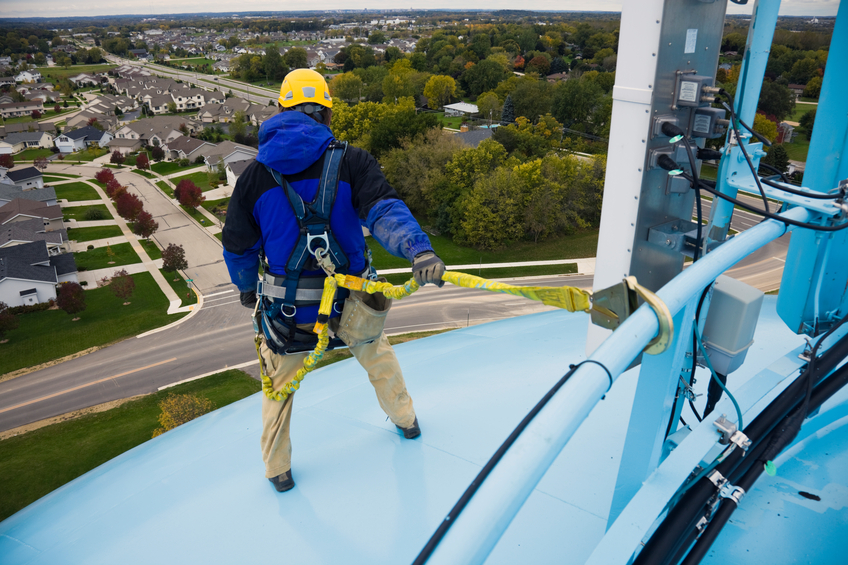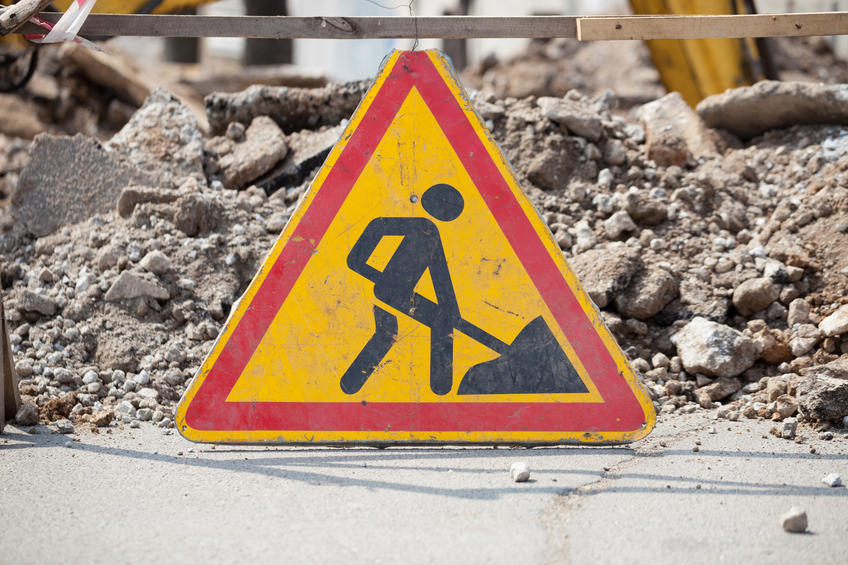District of Columbia Construction Safety and Ethics 20 PDH Discount Package 2
Courses in this Package
Fall Protection in Construction (C03-057)
Ground-Fault Protection on Construction Sites (E01-001)
Scaffold Use in the Construction Industry (S06-001)
Control of Hazardous Energy - Lockout/Tagout (E02-001)
Operational Safety on Airports During Construction (C07-016)
Code of Ethics for Engineers (LE1-001)

This online engineering PDH course presents the OSHA guidelines for fall protection for protecting workers against potential fall hazards.
Historically, falls are the leading cause of fatalities in construction, accounting for about one-third of all fatalities in the industry. Workers involved in working at heights are exposed to potential fall hazards. Accidents involving falls are generally complex events frequently involving a variety of factors
OSHA recognizes that working at heights presents serious hazards to all workers involved. Consequently, the standard for fall protection deals with both the human and equipment-related issues in protecting workers from fall hazards.
This 3 PDH online course is intended for employers/business owners, engineers, managers and construction workers interested in better understanding the Fall Protection in Construction requirements and the reasons behind them.
This PE continuing education course is intended to provide you with the following specific knowledge and skills:
- Identifying potential fall hazards
- Selecting fall protection systems appropriate for existing conditions
- Implementing proper construction and installation of safety systems
- Training and supervising employees in the proper selection, use and maintenance of fall protection systems
In this professional engineering CEU course, you need to review the OSHA Standard, "Fall Protection in Construction", (OSHA 3146), published in 2015.
Once you complete your course review, you need to take a multiple-choice quiz consisting of twenty (20) questions to earn 3 PDH credits. The quiz will be based on this OSHA publication.
Upon successful completion of the quiz, print your Certificate of Completion instantly. (Note: if you are paying by check or money order, you will be able to print it after we receive your payment.) For your convenience, we will also email it to you. Please note that you can log in to your account at any time to access and print your Certificate of Completion.

This online engineering PDH course provides OSHA's electrical requirements for ground fault circuit interrupters to protect workers against electrical hazards.
With the wide use of portable tools on construction sites, the use of flexible cords often becomes necessary. Hazards are created when cords, cord connectors, receptacles, and cord- and plug-connected equipment are improperly used and maintained. Shocks, burns or fire-related fatalities resulting from humans exposed to non-grounded equipment significantly contribute to the overall number of fatalities in the construction workplace.
OSHA recognizes that non-grounded equipment present serious hazards to all workers involved. Therefore, OSHA developed the Electrical Standard that contains the requirements for ground fault circuit interrupters (GFCIs) to protect workers against 120-volt electrical hazards on the construction site.
This 1 PDH online course is applicable to employers/business owners, engineers, managers, electricians, construction workers and any other personnel working with or around energized equipment that require grounding.
This PE continuing education course is intended to provide you with the following specific knowledge and skills:
- What is a GFCI
- What are some other ways to prevent electrical injury
- How can employers protect their workers
- What is the assured equipment grounding conductor program
In this professional engineering CEU course, you need to review OSHA 3007, "Ground-Fault Protection on Construction Sites".
Upon successful completion of the quiz, print your Certificate of Completion instantly. (Note: if you are paying by check or money order, you will be able to print it after we receive your payment.) For your convenience, we will also email it to you. Please note that you can log in to your account at any time to access and print your Certificate of Completion.

This online engineering PDH course provides OSHA guidance on scaffolds for protecting workers using scaffolding systems on construction sites.
Scaffolding hazards continue to rank high on the list of most frequently cited standards in the construction industry. Workers involved in working on scaffolding systems are exposed to potential fall hazards. Scaffold-related accidents account for a significant number of fatalities in the construction workplace.
OSHA recognizes that working on scaffolding systems present serious hazards to all workers involved. Therefore, OSHA developed the Scaffold Standard to protect workers using scaffolding systems on construction sites.
This 6 PDH online course is applicable to employers/business owners, engineers, managers, construction contractors/workers and any other personnel working on construction projects that require scaffolding.
This PE continuing education course is intended to provide you with the following specific knowledge and skills:
- Scaffold capacity requirements
- Scaffold platform requirements
- Criteria for supported scaffolds versus suspended scaffolds
- Access and use requirements
- Fall and falling object requirements
- Specific scaffold and aerial lift requirements
- Training requirements
- Construction focused inspection guidelines
In this professional engineering CEU course, you need to review OSHA 3150, "A Guide to Scaffold Use in the Construction Industry".
Upon successful completion of the quiz, print your Certificate of Completion instantly. (Note: if you are paying by check or money order, you will be able to print it after we receive your payment.) For your convenience, we will also email it to you. Please note that you can log in to your account at any time to access and print your Certificate of Completion.

This online engineering PDH course presents OSHA guidance on the control of hazardous energy for protecting workers from the release of hazardous energy.
Employees can be seriously or fatally injured if machinery they service or maintain unexpectedly energizes, starts up, or releases stored energy. If the potential exists for the release of hazardous stored energy or for the re-accumulation of stored energy to a hazardous level, the employer must ensure that the employees take steps to prevent injury that may result from such release.
OSHA recognizes the risk of employees being exposed to the release of hazardous stored energy. Therefore, OSHA developed the Control of Hazardous Energy Standard to protect employees from the unexpected energization or startup of machinery or equipment, or the release of hazardous energy during service or maintenance activities.
This 2 PDH online course is applicable to employers, building owners, engineers, managers, electricians, construction workers and any other personnel who are involved in servicing and maintaining electrical machinery or equipment.
This PE continuing education course is intended to provide you with the following specific knowledge and skills:
- Elements of The Energy-Control Procedure
- Responsibilities of Workers When Servicing or Maintaining Energized Machinery
- Applicability of Lock-Out Procedures
- Applicability of Tag-Out Procedures
- Lock-Out Versus Tag-Out Applications
- Employee Training
In this professional engineering CEU course, you need to review OSHA 3120, "Control of Hazardous Energy (Lockout/Tagout)".
Upon successful completion of the quiz, print your Certificate of Completion instantly. (Note: if you are paying by check or money order, you will be able to print it after we receive your payment.) For your convenience, we will also email it to you. Please note that you can log in to your account at any time to access and print your Certificate of Completion.

This online engineering PDH course discusses the key areas for maintaining safety during construction at an airport. It presents details on how to maintain a functioning airport during construction, how to keep construction zones safe, and when to have specific zones open or close during construction.
Safety at construction zones is paramount, and this is even more so at airports where multiple stakeholders are involved in the construction process, including but not limited to the FAA, airport operators, contractors, airport users, and military personnel (at military airports).
This 7 PDH online course is applicable to architects, construction managers, safety, civil, electrical, mechanical, and industrial engineers as well as others interested in learning more about how construction at an airport can be performed safely.
This PE continuing education course is intended to provide you with the following specific knowledge and skills:
- Understanding why maintaining safety at an airport during construction is important
- Learning how to best keep all involved parties and stakeholders safe
- Understanding what is involved in creating a construction safety and phasing plan (CSPP)
- Familiarizing with the guidelines on how to create a construction safety and phasing plan (CSPP)
Upon successful completion of the quiz, print your Certificate of Completion instantly. (Note: if you are paying by check or money order, you will be able to print it after we receive your payment.) For your convenience, we will also email it to you. Please note that you can log in to your account at any time to access and print your Certificate of Completion.

This online engineering PDH course introduces engineers to the National Society of Professional Engineers Code of Ethics. The Code provides ethical guidance to engineers in their various and often simultaneously held roles as 1) guardians of public health, safety, and welfare 2) employees, 3) employers, and 4) providers of technical service to clients.
Engineers practicing their profession encounter not only technical issues but also ethical issues. Sometimes the latter issues are easy to resolve: applying everyday, common-sense notions of honesty, openness, responsibility, and lawfulness is sufficient to guide the engineer to the appropriate decision. At other times, however, matters are more complicated. In particular, knowing what to do when two or more duties or obligations conflict can be difficult. For example, an engineer's duty to his client or employer may conflict with the engineer's duty to the general public. Codes of ethics have been formulated to help engineers address these conflicts.
This 1 PDH online course is intended for all engineers who are interested in gaining a better understanding about how to protect and respect their engineering profession in the utmost manner.
This PE continuing education course is intended to provide you with the following specific knowledge and skills:
-
Learning the six Fundamental Canons of the Code
-
Learning the five Rules of Practice
-
Learning the nine Professional Obligations
-
Understanding the definition of "Sustainable Development"
-
Understanding the scope of the Supreme Court decision regarding NSPE, competitive bidding, and antitrust law
In this professional engineering CEU course, you need to review the course document "Code of Ethics for Engineers" published by the National Society of Professional Engineers (NSPE) on July 2007. This course document is reprinted by permission of the NSPE (www.nspe.org) and may be downloaded from the NSPE's website by clicking on Code of Ethics for Engineers, or by clicking on the link below.
Once you complete your course review, you need to take a multiple-choice quiz consisting of ten (10) questions to earn 1 PDH credit. The quiz will be based on this NSPE publication.
Upon successful completion of the quiz, print your Certificate of Completion instantly. (Note: if you are paying by check or money order, you will be able to print it after we receive your payment.) For your convenience, we will also email it to you. Please note that you can log in to your account at any time to access and print your Certificate of Completion.